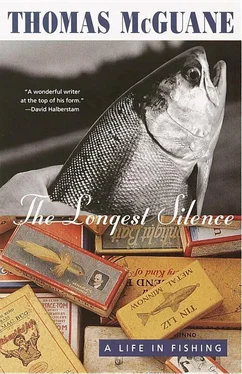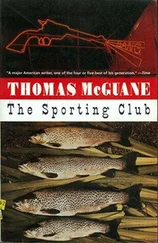“Let them come in now,” Woody said.
“I want to nail one, Woody.”
“You will. Let them come.”
The fish, six of them, were surging toward us in a wedge. They ran from 80 to 110 pounds, slow, dark torpedoes. “All right, the lead fish, get on him,” Woody said. I managed the throw, the fly falling in front of the fish. I let them overtake it before starting my retrieve. The big lead fish pulled up behind the fly, trailed, and then made the shoveling, open-jawed uplift of a strike that is not soon forgotten. When he turned down I set the hook and he started his run. The critical issue of getting rid of that loose line piled around one’s feet now ensued. You imagine that if you are standing on a coil, you will go to the moon when that coil must follow its predecessors out of the rod. This trial went off without a hitch, and it was only my certainty that someone had done it before that kept me from deciding that we’d made a huge mistake.
The sudden pressure of the line and the direction of its resistance apparently confused the tarpon, so it raced in close-coupled arcs around the boat. Then, once it had seen the boat, felt the line and isolated a single point of resistance, it cleared out at a perfectly insane rate of acceleration that made water run three feet up my line as it sliced through the ocean. The jumps — wild, greyhounding, end-over-end, rattling — were all crazily blurred as they happened, while I pictured my reel exploding like a racing clutch and filling me with shrapnel. This fish, the first of six that day, broke off. So did the others, destroying various aspects of my tackle.
As the sun moved through the day the blind side continually changed, forcing us to adjust position until, by afternoon, we were watching to the north. Somehow, looking uplight, Woody saw four permit coming right toward us, head-on. I cast my tarpon fly at them, out of my accustomed long-shot routine, and was surprised when one fish moved forward from the pack and followed up the fly rather aggressively. About then they all sensed the skiff and swerved to cross the bow around thirty feet out. They were down close to the bottom now, slightly spooked. I picked up, changed direction, and cast a fairly long interception. When the fly lit, well out ahead, two permit elevated from the group, sprinted forward, and the inside fish took the fly in plain view.
The positive certainty of the take, in the face of an ungodly number of refusals and countless unrewarded hours, induced immediate pessimism. I waited for everything to go haywire.
I hooked the fish quickly. It was only slightly startled and returned to the pack, which by this time had veered away from the shallow flat edge and swung back toward deep water. The critical time of loose line passed slowly. Woody unstaked the skiff and was poised to see which way the fish would take us. When the permit was tight to the reel I cinched him once and he began running. The deep water kept the fish from making the long, sustained sprints permit make on the flats. This fight was a series of assured jabs at various clean angles from the skiff. We followed, alternately gaining and losing line. Then, in some way, at the end of this blurred episode, the permit was flashing beside the boat, looking nearly circular, and the only visual contradiction to his perfect poise was the intersecting line of leader seemingly inscribed from the tip of my arcing rod to the precise corner of his jaw.
Then we discovered that there was no net in the boat. The fish would have to be tailed. I forgave Woody in advance for the permit’s escape. Woody was kneeling in the skiff, my line disappearing over his shoulder, the permit no longer in my sight, Woody leaning deep from the gunwale. Then, unbelievably, his arm was up, the black symmetry of tail above his fist, the permit perpendicular to the earth, then horizontal on the floorboards, where a pile of loose line was strewn in curves that wandered around the bottom of the boat toward the gray-and-orange fly secured in the permit’s mouth. I sat down numb and soaring.
I don’t know what this sort of occurrence indicates beyond the necessary, ecstatic resignation to the moment. With the beginning over and, possibly, nothing learned, I was persuaded that once was not enough. And indeed it wasn’t. Thirty years have passed and none of the magic of permit fishing, not a trace of it, has gone.
ONE IS TEMPTED to think of bonefish as among the wildest of creatures, if a sensory apparatus calculated to separate them continually from man’s presence qualifies them as “wild.” Yet, when the serious angler insinuates himself into the luminous, subaqueous universe of the bonefish and catches one without benefit of accident, he has, in effect, visited another world, one whose precise cycles and conditions appear so serene that the addled twentieth-century angler begins to be consoled for all he has done to afford the trip in the first place. In his imagination he is emphatic about emptiness, space, and silence. He is searching less for recreation than for a kind of stillness.
Only the utterly initiated consider the bonefish handsome. Those new to or stupid about the sport think the fish is silly-looking, but those who know him well grant the bonefish a radiant, nearly celestial beauty. To me, he seems so perfectly made for both his terrain and my needs as a fisherman that he has the specificity of design seen in experimental aircraft. The nose, it is true, has a curious slant, and there is an undershot mouth that we, with our anthropocentrism, associate with lack of character, yet after a while you see that the entire head is rather hydrodynamic and handsomely vulpine.
The body is sturdy, often a radiant gray-green above and pure silver on the sides. The tail, like the fins, is frequently a gunmetal gray and is oversized and powerful, as exaggeratedly proportioned to its size as are the fish’s speed and power.
A bonefish doesn’t jump. From the fish’s point of view, the jump is a wasteful and often ruinous enterprise. Tarpon customarily wreck themselves jumping, which is the only thing that enables us to take the large ones on light tackle at all. So people who like to be photographed with all the spectacle associated with themselves, their fishing paraphernalia and their aerobatic catch ought to forget bonefish and concentrate on tarpon. Hang a tarpon up at the dock and it will suck gawkers off the highway like a vacuum cleaner. A dead bonefish at dockside barely draws flies.
It took me a month to catch my first bonefish, and I regret to say that I killed it and put it in the freezer. I had no boat and haunted the roadside flats, especially at Ohio-Missouri Key, finally catching one at Big Torch after pushing my way through the mangroves and stumbling onto a mud flat where some gullible fish were feeding. For a long time, at the drop of a hat, I would take it out, rigid as a fungo bat, to show to my friends. One said it was small. Another noted that the freezer had given it sunken eyes and a morbid demeanor. I asked how you could speak of demeanor in something which had departed this world. It was the last bonefish I kept.
Hard as it may be to believe, the bonefish leads his life in his extensive multiocean range quite without reference to the angler. For example, off the coast of Hawaii he has taken himself to great depths, where he is of no earthly use to the light-tackle fisherman. His poor manners extend to the African coast, where he reveals himself occasionally to cut-bait anglers of the high surf who smother his fight with pyramid sinkers that a Wyoming wrangler might use to keep the horses handy.
For these transgressions of fair play the human race can best revenge itself upon the bonefish in the shallows of Central America, Christmas Island, the Bahamas, and the Florida Keys. From a topographical perspective, this immensely distributed fish seems to be all over the place, but the angler will resort to low tricks and importuning the deity for just one. In the back of his mind, he recalls that marine biologists describe the bonefish as “widely distributed.” It doesn’t help.
Читать дальше












